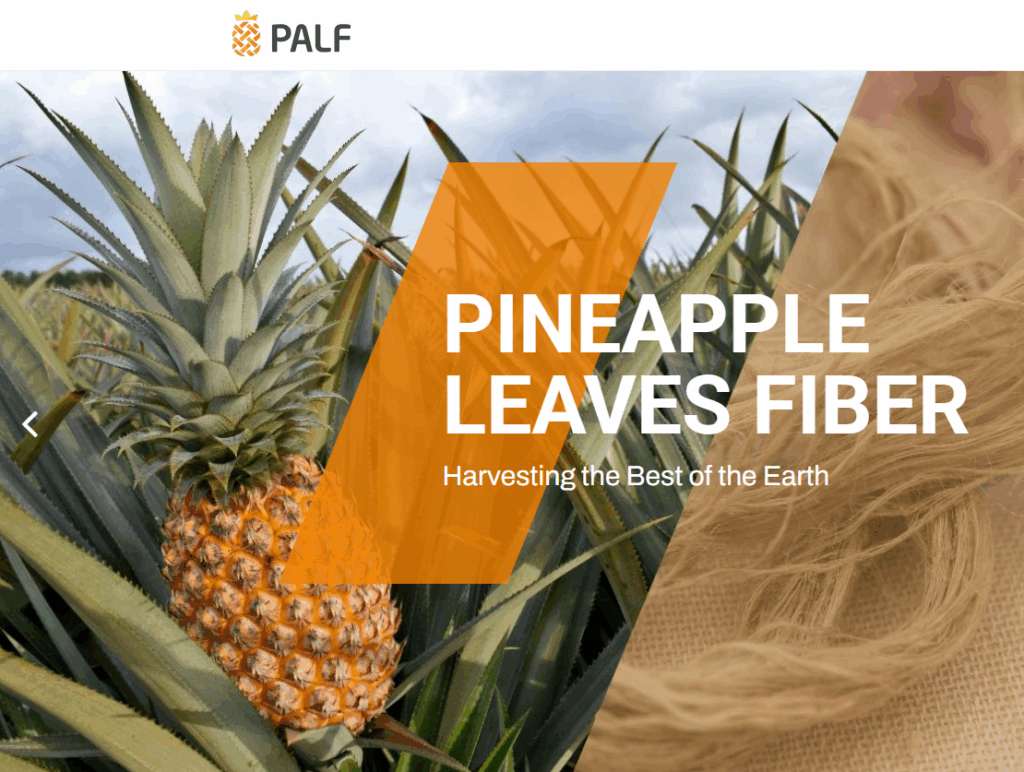As the textile industry grapples with the mounting need for sustainable materials, pineapple leaf fiber (PALF)—also known as Piña fiber—has risen as a natural, biodegradable, and resource-efficient alternative. Extracted from the agricultural waste of pineapple farming, this remarkable fiber not only reduces environmental harm but also holds the potential to support local economies and redefine what sustainability in fashion can look like.
What is Pineapple Leaf Fiber (PALF)?
PALF is extracted from the long, tough leaves of the pineapple plant, typically discarded after fruit harvesting. Traditionally treated as waste—burned or left to decompose—these leaves are now being upcycled into valuable raw material, in line with circular economy principles.
Composed primarily of cellulose, lignin, and hemicellulose, PALF is known for its strength, lightness, and natural sheen. These qualities make it suitable for a wide range of uses, from fashion textiles and accessories to composites used in furniture and even automotive interiors.
Environmental Benefits of PALF
🌱 1. Waste Reduction & Upcycling
By converting post-harvest pineapple leaves into fiber, PALF production significantly reduces agricultural waste and prevents harmful CO₂ emissions that result from burning. For example, burning 33 kg of leaves emits around 6 kg of CO₂—emissions that can be avoided through fiber extraction.
🌿 2. Biodegradability
Unlike synthetic fibers like polyester, which persist in the environment for hundreds of years, PALF naturally decomposes without releasing toxins, enriching soil when composted and eliminating long-term waste accumulation.
🌊 3. Microplastic-Free
PALF offers a natural alternative to synthetic textiles that contribute to microplastic pollution in marine ecosystems. Its use can help reduce plastic waste entering the oceans through washing and wearing of conventional garments.
⚡ 4. Energy & Resource Efficiency
PALF production is low in water and chemical use. Pineapples require relatively modest inputs compared to cotton, and the drying process uses solar energy. Life Cycle Assessment (LCA) studies indicate that PALF has a smaller energy footprint than many traditional and synthetic fibers.
🌾 5. Biodiversity Protection
Since pineapple plants are not grown solely for fiber, PALF does not require additional land clearing, preventing deforestation and preserving biodiversity. This sustainable practice supports existing agricultural systems without expanding their footprint.
Socio-Economic Impact
Beyond its environmental promise, PALF also presents social and economic opportunities, especially in pineapple-growing regions like the Philippines, Bangladesh, and parts of Africa:
- ✅ Job Creation: From farming to fiber extraction, spinning, and weaving, PALF supports inclusive employment across the supply chain.
- ✅ Women Empowerment: In many communities, women lead the processing stages, gaining economic independence and skills development.
- ✅ Local Brand Development: Designers embracing PALF often incorporate cultural heritage and craftsmanship, adding unique value to their products.
Challenges Ahead
Despite its many advantages, PALF is not without obstacles:
🔧 1. Labor-Intensive Processing
PALF extraction involves multiple manual stages—harvesting, retting, fiber scraping, drying, spinning, and weaving—making it time-consuming and costly without mechanization.
🚫 2. Technological Gaps
Many regions lack the machinery needed for efficient and scalable PALF processing. Investment in R&D is vital to improve output while preserving fiber quality.
💡 3. Limited Market Awareness
PALF is still relatively unknown in mainstream markets, and consumer education is key to increasing demand for cheaper, synthetic fabrics.
🧵 4. Durability Limitations
Though strong and elegant, PALF may not match synthetics in heavy-use or high-abrasion scenarios, limiting its application in certain types of apparel or industrial textiles.
💧 5. Water Usage in Retting
While overall water use is low, the retting stage (soaking the leaves to extract fiber) requires proper management to avoid water waste or contamination, especially in regions with water scarcity.
The Road Forward
To unlock PALF’s full potential, several strategies must align:
- 🏭 Innovate and mechanize fiber processing to reduce costs and increase scale.
- 📣 Raise consumer awareness about PALF’s environmental and social benefits.
- 📈 Support policy frameworks that incentivize sustainable materials in fashion.
- 🌍 Foster global collaboration to set quality standards and drive fair trade.
Conclusion: Sustainability Rooted in Tradition
From discarded pineapple leaves to luxurious, earth-friendly fabrics, PALF represents a powerful narrative of transformation, innovation, and resilience. By choosing materials like pineapple leaf fiber, the fashion and textile industries can move toward a model that honors both people and the planet—proving that sustainability isn’t just a trend, but a future worth investing in.
🌿 Introducing EcoPALF by UKL: Pioneering Pineapple Fiber Innovation
Founded in Taipei in 1988, UKL Enterprise Co., Ltd. has built a sterling reputation in high-quality knitted apparel for international fashion brands. Building on this legacy, the company launched its Sustainable Materials Department in 2023, focusing on eco-innovation through pineapple leaf fiber (PALF) — Taiwan’s first locally sourced, zero-carbon natural fiber solution.
EcoPALF transforms agricultural waste—pineapple leaves—into premium yarns and fabrics using advanced, sustainable extraction and processing methods. With an impressively low carbon footprint of just 0.784 kg CO₂e and water savings up to 97% compared to cotton, each metric ton of PALF saves approximately 2.4 tons of CO₂ . Moreover, UKL’s PALF holds the USDA BioPreferred certification, ensuring a verified biobased content.
UKL has also achieved global recognition for its PALF innovations. In 2024, both its fabrics and finished pieces won two prestigious iF Design Awards, selected from over 11,000 entries. These accolades highlight their ability to blend design excellence with circular economy principles, turning waste pineapple leaves into award-winning, fashion-forward textiles.
Today, EcoPALF offers a sophisticated collection—ranging from sweaters and socks to vegan leather, home textiles, and paper—all crafted from pineapple fiber blends. Collaborating with organic farmers and using transparent supply chains, EcoPALF ensures quality, traceability, and social value, reinforcing UKL’s role as a leader in eco-conscious textile solutions.

